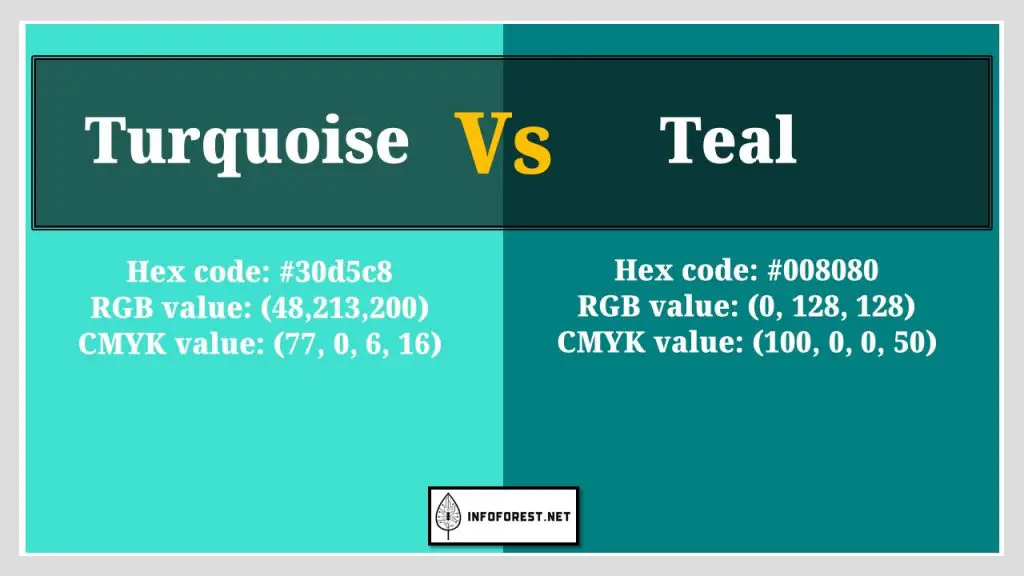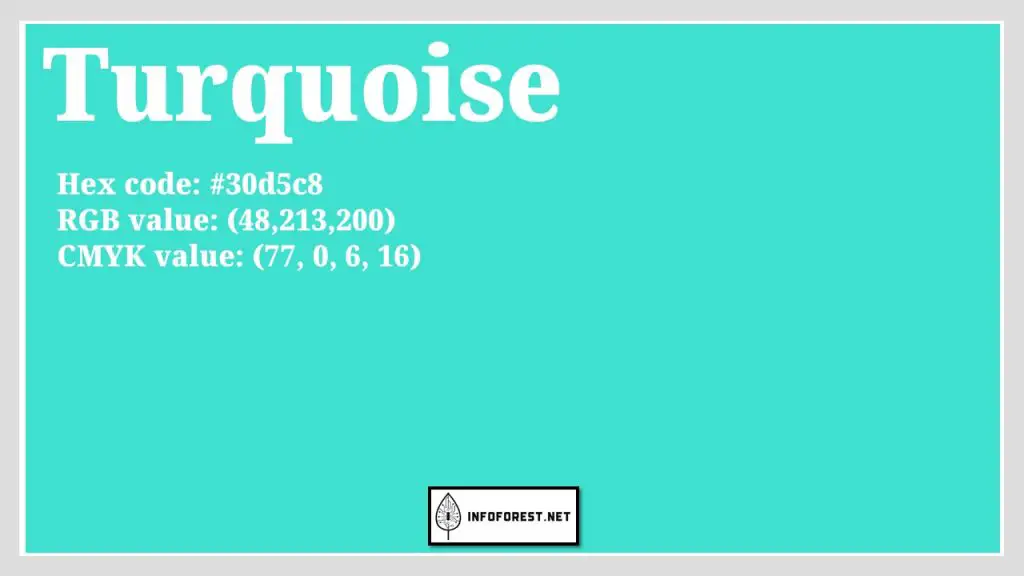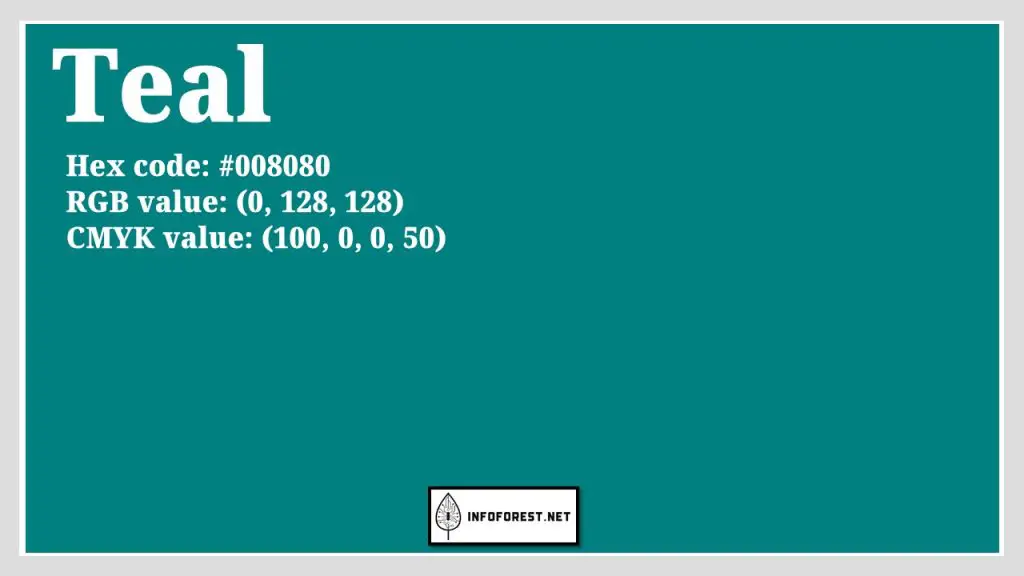
Teal and turquoise are both shades of blue-green, but there are some key differences between the two colors. Teal is a deeper, more muted shade of blue-green, while turquoise is a brighter and more vibrant color. In terms of the color spectrum, teal is a tertiary color that is made by mixing blue and green pigments together. Turquoise, on the other hand, is a secondary color that is formed by mixing blue and yellow pigments together.
In terms of their use and symbolism, teal is often seen as a more formal and sophisticated color, while turquoise is more playful and casual. Teal is often used in corporate branding, home decor, and fashion, while turquoise is more commonly used in beach and resort settings, and in bohemian or folk-inspired design. Both colors are associated with calmness, serenity, and a connection to nature, but teal may also be seen as a symbol of intelligence and professionalism.
Main differences between Teal and Turquoise
Here are some of the main differences:
- Color: Teal is a deeper, more muted shade of blue-green, while turquoise is a brighter and more vibrant color.
- Pigments: In terms of the color spectrum, teal is a tertiary color that is made by mixing blue and green pigments together. Turquoise, on the other hand, is a secondary color that is formed by mixing blue and yellow pigments together.
- Use and symbolism: Teal is often seen as a more formal and sophisticated color, while turquoise is more playful and casual. Teal is often used in corporate branding, home decor, and fashion, while turquoise is more commonly used in beach and resort settings, and in bohemian or folk-inspired design. Both colors are associated with calmness, serenity, and a connection to nature, but teal may also be seen as a symbol of intelligence and professionalism.
- Lightness and saturation: Teal is generally darker and more saturated than turquoise. Turquoise is a lighter and less saturated shade of blue-green.
To summarize, teal is a deeper and more muted blue-green color, while turquoise is a brighter and more vibrant shade of blue-green. Both colors are associated with calmness and serenity, but teal is often seen as more formal and sophisticated, while turquoise is more playful and casual.

Difference between Teal and Turquoise Color Codes
Teal and turquoise are both shades of blue-green, and they each have their own unique color codes that can be used to identify and specify these colors in various design and media applications.
Here are the color codes for teal:
- Hex code: #008080
- RGB value: (0, 128, 128)
- CMYK value: (100, 0, 0, 50)
And here are the color codes for turquoise:
- Hex code: #30d5c8
- RGB value: (48,213,200)
- CMYK value: (77, 0, 6, 16)
Hex codes are a six-digit combination of letters and numbers that represent a specific color. They are commonly used in web design and HTML coding. RGB values specify a color in terms of its red, green, and blue components, and they are often used in digital media and computer graphics. CMYK values specify a color in terms of its cyan, magenta, yellow, and black components, and they are used in printing and other physical media.
Note that there may be some variation in the exact color codes for teal and turquoise, as these shades can appear differently depending on the lighting conditions and the device being used to view them.

Comparison Table
Here is a comparison table about this topic:
| Feature | Teal | Turquoise |
|---|---|---|
| Color | Deep blue-green | Light to medium blue-green |
| Pigments | Blue and green mixed together | Blue and yellow mixed together |
| Use and symbolism | Formal, sophisticated | Playful, casual |
| Lightness | Darker | Lighter |
| Saturation | More saturated | Less saturated |
| Hex code | #008080 | #30d5c8 |
| RGB value | (0, 128, 128) | (48,213,200) |
| CMYK value | (100, 0, 0, 50) | (77, 0, 6, 16) |
| Shade | Teal is a shade of blue-green, while turquoise is a pure blue-green color | Turquoise is a shade of blue-green, while teal is a pure blue-green color |
| Emotional associations | Calming, serene, professional | Calming, serene, playful |
Most Viewed Articles
Some examples in Nature
Here are some examples of teal and turquoise colors that can be found in nature:
- Teal: The wings of a peacock, the feathers of a teal duck, the iridescent scales of a fish, the deep blue-green waters of the ocean.
- Turquoise: The bright blue-green waters of a tropical lagoon, the vibrant blue-green plumage of a tropical bird, the iridescent wings of a butterfly, the blue-green patina on a piece of copper.
Both teal and turquoise are often associated with water, as these colors are often found in the oceans, lakes, and rivers of the natural world. They are also associated with the bright, vibrant colors of tropical environments, and with the shimmering iridescence of certain birds, butterflies, and other animals.
Conclusion
In conclusion, teal and turquoise are both shades of blue-green that are often used in fashion and design. Teal is a deeper, more muted shade of blue-green, while turquoise is a brighter and more vibrant color. Teal is often seen as a more formal and sophisticated color, while turquoise is more playful and casual. Both colors are associated with calmness and serenity, and they are often used in home decor, clothing, and accessories. However, there are some key differences between the two colors in terms of their pigments, lightness, saturation, and color codes. Teal is a tertiary color made by mixing blue and green pigments together, while turquoise is a secondary color made by mixing blue and yellow pigments together. Teal is generally darker and more saturated than turquoise, and it has a different set of color codes that can be used to identify and specify the color in various design and media applications.
We also invite you not to miss our other popular articles such as:
Difference between left and right Twix–Difference Between Eastern Time Zone and Central Time Zone–Difference Between Capitalism and Communism– Difference Between EST and EDT–How many weeks in a Year– Difference Between Evening and Afternoon and Difference Between Zip Code and Postal Code









